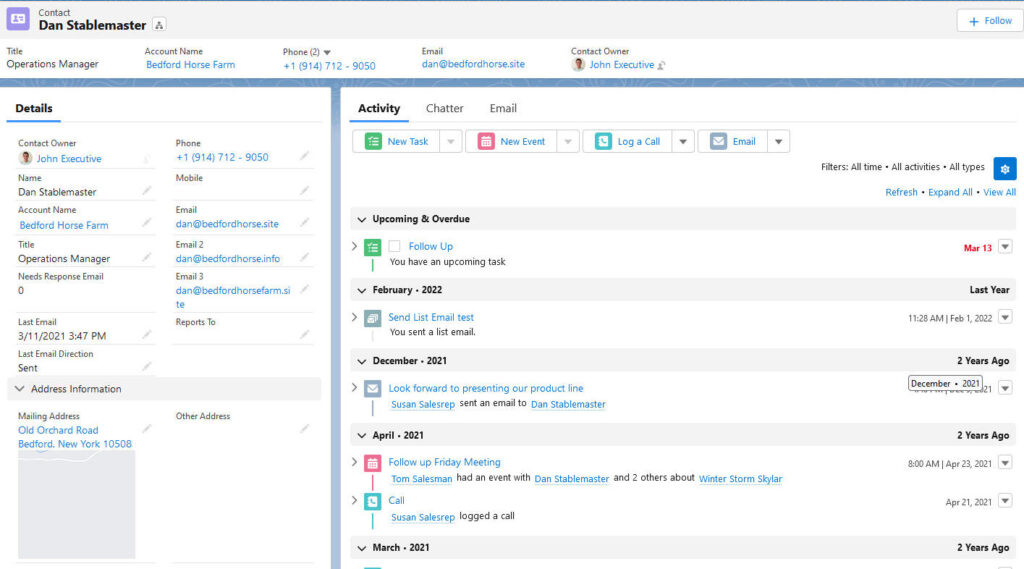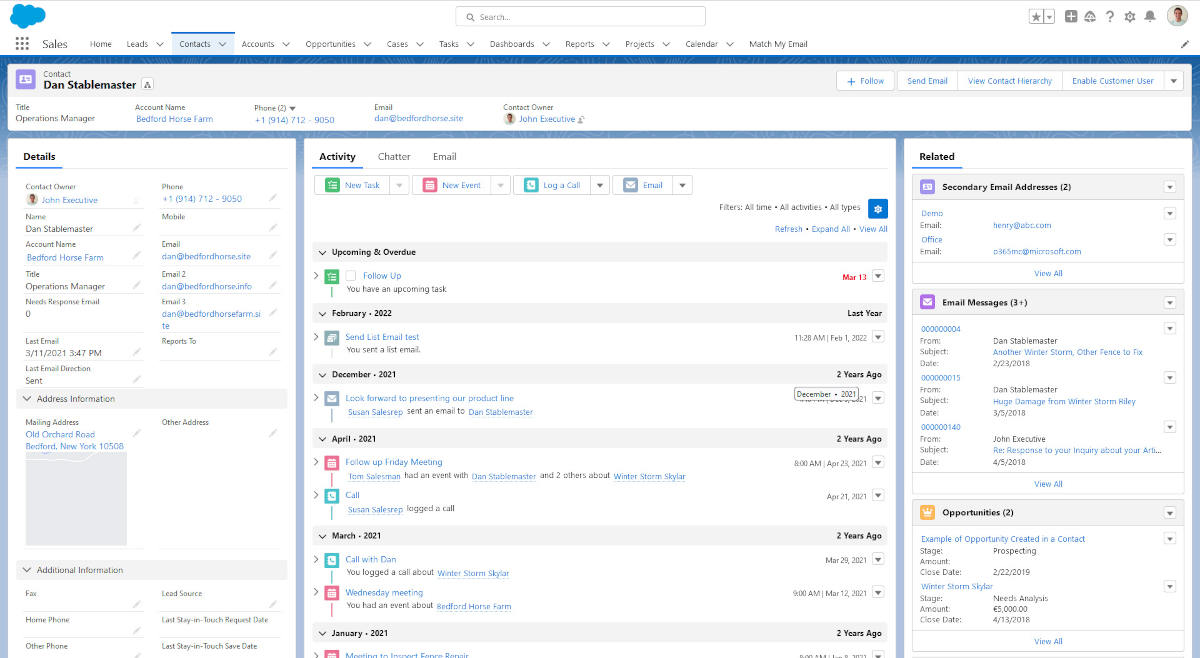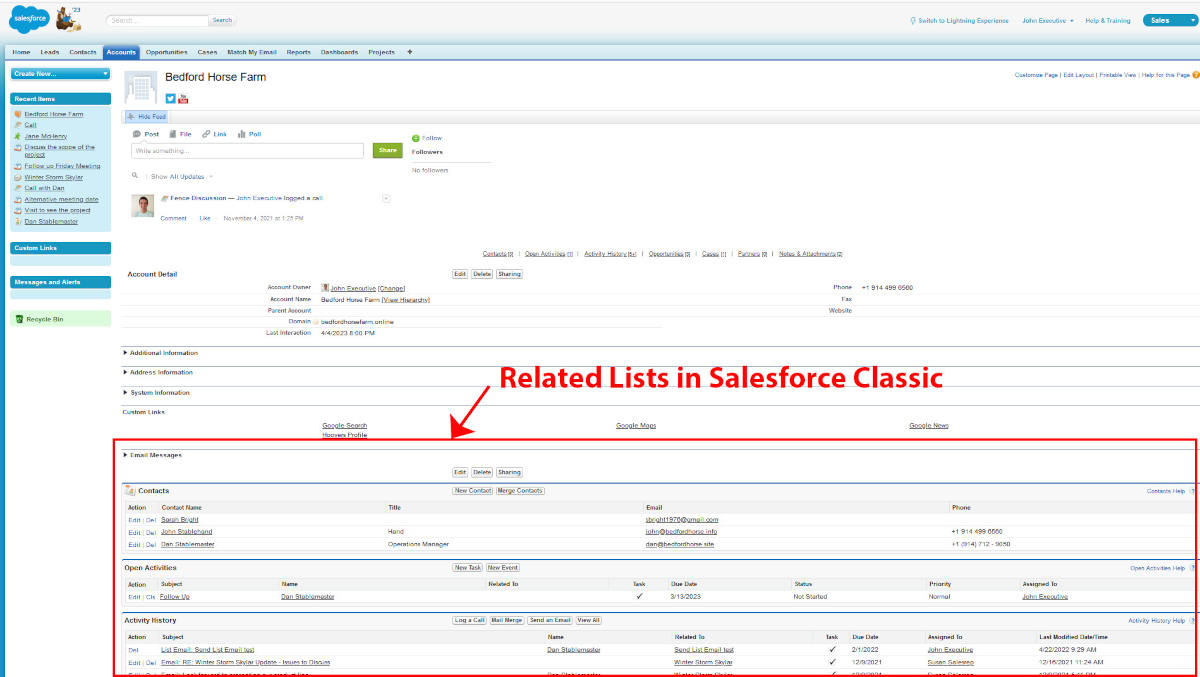Salesforce continues to amaze us with its powerful features and capabilities! The related lists in Salesforce is one such feature that smoothens out your information management process within the ecosystem. On top of that, it enhances your experience of using Salesforce and gets you the best results.
Want to learn how? In this blog, we’ll explore related lists and how they function within Salesforce. We’ll discuss their significance in improving your business and real-world examples that showcase their benefits.
Ready? Let’s dive in!
Table of Contents
ToggleWhat Are Related Lists in Salesforce?
A related list is a section on a record’s detail page. This section displays a list of related records from different objects that contain similar information to the record at hand. In Salesforce, you can view these related records without exiting the current record.
Let’s say you use Salesforce for your organization’s HR department. You have a standard object called “Employees” and other related objects that capture employee information. Now, when you access an employee’s record, you’ll also see related lists displaying relevant information about that employee.
It could be ”job history” that shows that employee’s past and current positions within the organization. Or it could be a “training and certifications” list that showcases all the employee’s completed training and certification statuses.
These related lists would make it easy to access and manage all employee-related information in one place and streamline HR management. Similarly, if you use Salesforce for sales, you’ll be able to see all accounts related to the one at hand – e.g., referrals, additional contacts, other departments, and more!
How Do Related Lists Work?
Related lists establish relationships between objects and display records within a parent object’s detail page:
Salesforce establishes a relationship between objects using lookup fields and master-detail relationships. These relationships define how a parent object is connected to its related child object. Upon establishing the relationship, Salesforce configures these related lists to be displayed on the detail page of the parent object.
Whenever a new record is created on the child object, it’s associated with a specific parent object by populating the lookup or relationship field. The related list component retrieves and displays the related records based on established relationships.
You can interact with the related records directly from the related list and perform actions such as creating new records, editing existing ones, or deleting records. You can also tailor these related lists based on your business needs and control the visibility, order, and number of records in each list.
Benefits of Using Related Lists
- Consolidated Views and Streamlined Data: With related lists, you get all the information in one place without navigating to different pages or objects. Moreover, you can easily update records directly from the parent record detail page. It’s easier to track and manage your data this way while saving time and prioritizing other critical activities.
- Improved User Experience: Related lists help you quickly access information without extensive searching or manually linking records. This enhances your overall experience of using Salesforce and keeps your team’s manual data entry work to a minimum.
- Related Lists in Salesforce Enhance Collaboration: When you need to keep track of tasks when managing a team, related lists can come in handy. You can get a centralized view of all the associated tasks for an employee or project, ensuring efficient task allocation and completion.
How Companies Use Related Lists in Salesforce
Software Teams Can Use Related Lists in Salesforce to Track Bugs
Related lists can display associated bug records, changes, and related cases on a case record’s detail page for easy access. This way, software teams can quickly identify the root cause of a bug by tracking related changes and promptly get to the solution.
Tracking Event Registration
Conducting an event can be a strenuous job if not managed properly. You can create related lists in Salesforce to display registrations, attendees, sessions, and speakers. This consolidated view simplifies event planning and improves communication.
Order and Inventory Management
Using related lists, you can display associated records for an order, such as shipments, invoices, and returns. This helps you streamline order fulfillment, improve inventory visibility and enable accurate financial reporting.
Patient and Healthcare Management
In the healthcare industry, related lists can show associated records on a patient’s record detail page, such as appointments, medical history, medications, and lab results. Similarly, if you’re in the financial industry, you could keep track of your clients with Salesforce.
How to Create Related Lists in Salesforce
Salesforce has two interface versions: Lightning and Classic. The Classic version is more traditional in terms of look and feel, while the Lightning version has a modern appearance. Moreover, the Lightning version has more customization features than the Classic version.
In short, Salesforce OG users prefer to work on Salesforce Classic, while those looking for advanced features and functionality opt for Lightning. We’ll review the process of creating related lists for both interfaces!
Creating Related Lists in Salesforce Lightning
- Login to your Salesforce account and head over to “setup.”
- Click on the “Object Manager” tab.
- Select the object you want to create related lists for.
- From the left sidebar menu, select “page layout.”
- On the “page layout” window, select the “account layout” option.
- On the “account layout” page, you’ll see a “related list” option.
- When you click “related list,” you’ll see related list items on the screen. You can simply drag and drop the related items into the related list section.
Click on “save.”
Creating Related Lists in Salesforce Classic
- Login to your Salesforce account and go to “setup.”
- Head over to “accounts” on the navigation bar.
- Select the account to want to create related lists for and click on “edit layout.”
- It opens the account layout page. From there, click on “related lists.”
- Drag and drop the related content into the related list section.
- Click on “save.”
Creating Custom Related Lists in Salesforce
Sometimes, the standard related list you create on Salesforce may not meet your specific needs or display the required information. This is why Salesforce allows you to create custom lists tailored to your requirements! Creating custom lists allows you to select a specific child object, define the relationship between the parent and child object, and customize the columns or fields displayed.
Here’s how the process goes:
- Login to your Salesforce account and go to “sales.”
- Click on a campaign object you want to create the related lists for.
- Once you’re on the campaign page, click on the gear icon (settings) and “edit object.”
- From the object manager page, select “page layouts” from the left sidebar.
- On the page layout screen, click on “campaign layout.”
- Select “related lists” from the left navigation bar.
- Drag and drop the related items from the screen into the related list section.
- Click on “save.”
Frequently Asked Questions (FAQs)
- How many fields are there in a related list in Salesforce?
You can add up to ten fields to your Salesforce org’s related list. Salesforce predetermines these specific fields and generally includes fields such as record name, date fields, and basic identifiers. - What is the use of a related list in Salesforce?
The primary use of a related list is to show records from a child object that have a relationship with the parent object. Using related lists, users can interact with the associated data without navigating to separate pages or performing additional searches. - Where do you find related lists?
You can locate related lists on the upper right corner of each object detail page. - What are dynamic related lists on Salesforce?
Salesforce allows you to filter related lists on a record page. You can add, remove, reorder, and sort columns in a list using dynamic related lists. - How to combine related lists in Salesforce?
You can merge multiple related lists on Salesforce of the same object and display them as one. Create a junction object with master detail fields for both objects and create a single related list on the junction object. - How to sort related lists in Salesforce?
Follow these instructions:- Go to the parent object and select “page layout.”
- Click on the gear (settings) icon.
- Select the field for sorting.
Maximize Your CRM Efficiency with Related Lists
Related lists are powerful tools for organizing and managing data in Salesforce.
Whether tracking customer relationships or account contacts, managing projects or tasks, or streamlining workflows, you can optimize various operations using related lists. Just remember to tailor related lists to your specific needs and use Salesforce’s flexibility and customization options to get more bang for your buck!






